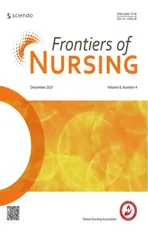Clinical nursing competency assessment:a scoping review
2021-12-29OboshieAnimBoamahChristmalDelaChristmalsSusanJenniferArmstrong
Oboshie Anim-Boamah, Christmal Dela Christmals*, Susan Jennifer Armstrong
Department of Nursing Education, School of Therapeutic Sciences, Faculty of Health Sciences, University of Witwatersrand,Johannesburg-Braamfontein, Gauteng 2050, South Africa
Abstract: Objective: To ensure that only competent graduates are licensed to practice nursing, councils conduct licensing examinations, which may include among others clinical competency assessment. This review explored current practices in clinical competency assessment of nursing students as part of a larger study aimed at developing an evidence-based, context-specific framework for clinical competency assessment in a sub-Saharan African (SSA) country.
Keywords: clinical competency assessment • licensing examination • nursing • scoping review • sub-Saharan Africag
1. Introduction
The International Council of Nurses (ICN) defines competence as the effective application of a combination of knowledge, skills, and judgment in practice.1Nursing is a practice-based profession where clinical placement,teaching, and learning are essential for students to acquire the necessary competencies for professional practice.2–4To ensure that only competent graduates are licensed to practice, nursing councils conduct licensing examinations, which may comprise clinical competency assessments.5–7
Assessment is the process of gathering and evaluating information on what an individual knows and he/she can do to make an informed decision about the next steps in the educational process or professional life.8,9In Nursing Education Institutions (NEIs), students’continuous and summative assessments in the three main domains of learning (cognitive, affective, and psychomotor) are conducted.10Summative assessment in health profession educational programs aims to ensure that decisions such as progression and licensing, and prediction of future performance, are evidence-based.9Assessment goes beyond an exercise that enables students to acquire a grade to pass a course; rather, a student may be required to use a combination of knowledge, skills, and attitudes that were learned in their theory and practice.11–13
The importance of quality clinical assessment in nursing cannot be overemphasized as a proper assessment of clinical competence has a positive influence on patient care.14Assessment is said to be of good quality if it is valid, fair, transparent, reliable, feasible, and has an educational impact.11,15An assessment system should have the ability to accurately differentiate competent students from incompetent ones.16
In a recent review of nursing competency assessment in general, Reljić et al.17stated that there are three main types of clinical competency assessment:observation, self-assessment, and a combination of both – the most common of all being the structured observation using rubrics. Reljić et al.17concluded that notwithstanding the system, approach, and model or framework used for clinical competency assessment,it should measure knowledge, clinical skills, and problem-solving skills. Lastly, the review proposed further research to develop and validate a reliable clinical competency assessment tool (system).17The purpose of this study is to explore current practices in clinical competency assessment of nursing students globally. This review forms part of a larger study aimed at developing an evidence-based, context-specific framework for clinical competency assessment in a sub-Saharan African(SSA) country.
2. Methods
2.1. Design
This scoping review was guided by the Preferred Reporting Items for Systematic reviews and Meta-Analyses extension for Scoping Reviews (PRISMA-ScR).18Scoping reviews synthesize findings from empirical qualitative, quantitative and mixed-method studies. According to Christmals and Armstrong,19scoping reviews are conducted either as pre-systematic or free-standing reviews to synthesize findings from empirical and gray literature on a complex concept. “Clinical competency assessment” is a complex concept, hence the choice of methodology.
2.2. Search and inclusion
Five databases, Scopus, PubMed, CINAHL, Wiley Online Library, and ProQuest, were searched using varying combinations of the keywords: (Nursing OR Clinical) AND (Competence OR skill OR performance)AND (assessment OR evaluation). Peer-reviewed literature published in English from 2014 to 2019 that meet the objective of the study were included. The studies identified were imported into the Mendeley reference manager group where all duplicates were removed.20,21All titles were scanned, abstracts, where the study titles were related to the study objectives, were read, and full texts of the abstracts that met the inclusion criteria were retrieved by two independent reviewers. The two reviewers met and compared their list to reconcile their inclusion and exclusion decisions. There were no contentions on any study, hence there was no need for an adjudicator.
2.2.1. Studies includedThe search produced 1151 studies from the databases. Thirty-nine (39) duplicates were identified and merged, leaving 1112 studies. After screening the titles of the 1112 remaining studies, 1063 were excluded leaving 49 studies. The full articles of the 49 studies left were retrieved and critically evaluated.Twenty-eight (28) studies were finally included in this review, comprising 18 quantitative studies, 4 qualitative studies, 3 mixed-method, and 3 multimethod studies (Figure 1).
Of the studies included, 13 (46.4%) were conducted in Europe followed by the Middle East (5,17.9%), Americas (3,10.7%), Asia (3,10.7%), Australia (3,10.7%).Only one study (3.6%) included was from Africa (Figure 2). Of the 28 papers, 19 either developed or validated a clinical assessment tool or model. Participants were mostly nursing students, while other studies included qualified nurses. Two of the studies16,22neither included input from nursing students nor did they use data collected from them.
2.3. Data charting and synthesis

Figure 2. Distribution of papers included.
Data were extracted from studies using an adapted extraction sheet (Table 1) from De Souza and Carvalho.23Author and setting, the aim of the study,methodology, data collection and analysis, and key findings were extracted. All the quantitative results were qualitized and synthesized with the qualitative data, using a convergent integrated approach.24Data were synthesized using the five-stage data analysis method outlined by Whittemore and Knafl25: reduction,data display, data comparison, drawing of conclusions,and verification.2
2.3.1. Quality appraisal
The Joanna Briggs Institute (JBI) Critical Appraisal tools were used to evaluate the studies included in this study.The reviewers agreed that a study would be included if it met 80% of the criteria set in each of the JBI Critical Appraisal tools.50All the included studies met the quality criteria for inclusion.

Author, country and region Aim of the studyDesignData analysis, outcomes,instruments Key findings Quantitative studies included in the review 1. Ahn and Hyun-Young,Korea26 Students rated guided reflection and fidelity highly in the designed simulations.Learning objectives were appropriate for third-year students Simulations led to higher self-confidence of students.Improved performance in course material may be achievable with the addition of rigorous simulation design.2. Oetker-Black et al.,Tanzania27 To implement two high-fidelity simulations to help nursing students integrate their cognitive and psychomotor skills to evaluate the students’simulation experience using the Simulation Design Scale and learning outcomes.To analyze the correlation between students’ simulation experience and these learning outcomes.Quasi-experimental post-test design.Five nursing experts and 69 nursing students ANCOVA was used to compare the experimental and control groups, and correlation coefficient analysis was used to determine the correlation among them.To psychometrically evaluate the Clinical Skills Self-Efficacy Scale in a population of nursing students in Tanzania.Psychometric evaluation.287 nursing students enrolled in the preservice or in-service nursing programs at two schools Item analysis, reliability and validity were assessed.CSES included 12 items in a confidence scale designed to measure clinical skills self-efficacy expectations.Evidence of construct validity.Future research to focus on self-efficacy and the successful transferal of clinical skills learned in a simulated laboratory to the clinical setting.3. Teixeira et al., Brazil28 To compare the level of anxiety and performance of nursing students when performing a clinical simulation through the traditional method of assessment with the presence of an evaluator and a filmed assessment without the presence of an evaluator.Randomized control trial.20 nursing students were randomly assigned to one of two groups.The level of anxiety was assessed using the Zung test and performance was measured based on the number of correct answers.The final scores of the two groups correspond to mild anxiety.There was no difference between the groups.4. Alamri and Almazan,Saudi Arabia29 Physical assessment is not often practiced in clinical settings.Barriers identified were reliance on others and technology,ward culture, lack of influence on patient care.Continuous exposure,increasing self-confidence and enhancing the quality of planning and promotion of the nursing students could help develop necessary skills.5. Alquwez et al.,Saudi Arabia14 To examine the barriers to physical assessment skills among nursing students in a government university in the Arab Peninsula.A cross-sectional research survey.206 nursing students participated.A standardized questionnaire was used.Independent Samples t-test and paired t-test were used to analyze the data.Students expressed positive perceptions toward their patient safety competencies.Significant differences in patient safety competence of nursing students between universities, gender, and year of study were recorded.6. Arbabshastan et al.,Iran30 To assess the perceived patient safety competence during clinical training of Saudi nursing students.Descriptive, crosssectional design.829 nursing students.Descriptive and inferential statistics were used to analyze the data.To determine the status of clinical competencies nurse practitioner students —self and instructor assessment.Analytical crosssectional study.All senior nurse students (n = 50)from a bachelor degree program.The checklist contained 16 items with Yes and No options and a selfassessment form to be completed after each competency.Descriptive T-test was used to analyze data.The lowest scores of competencies were from communication and hygiene The development of clinical competencies requires close mentorship from someone who can provide feedback to students.
(Continued)
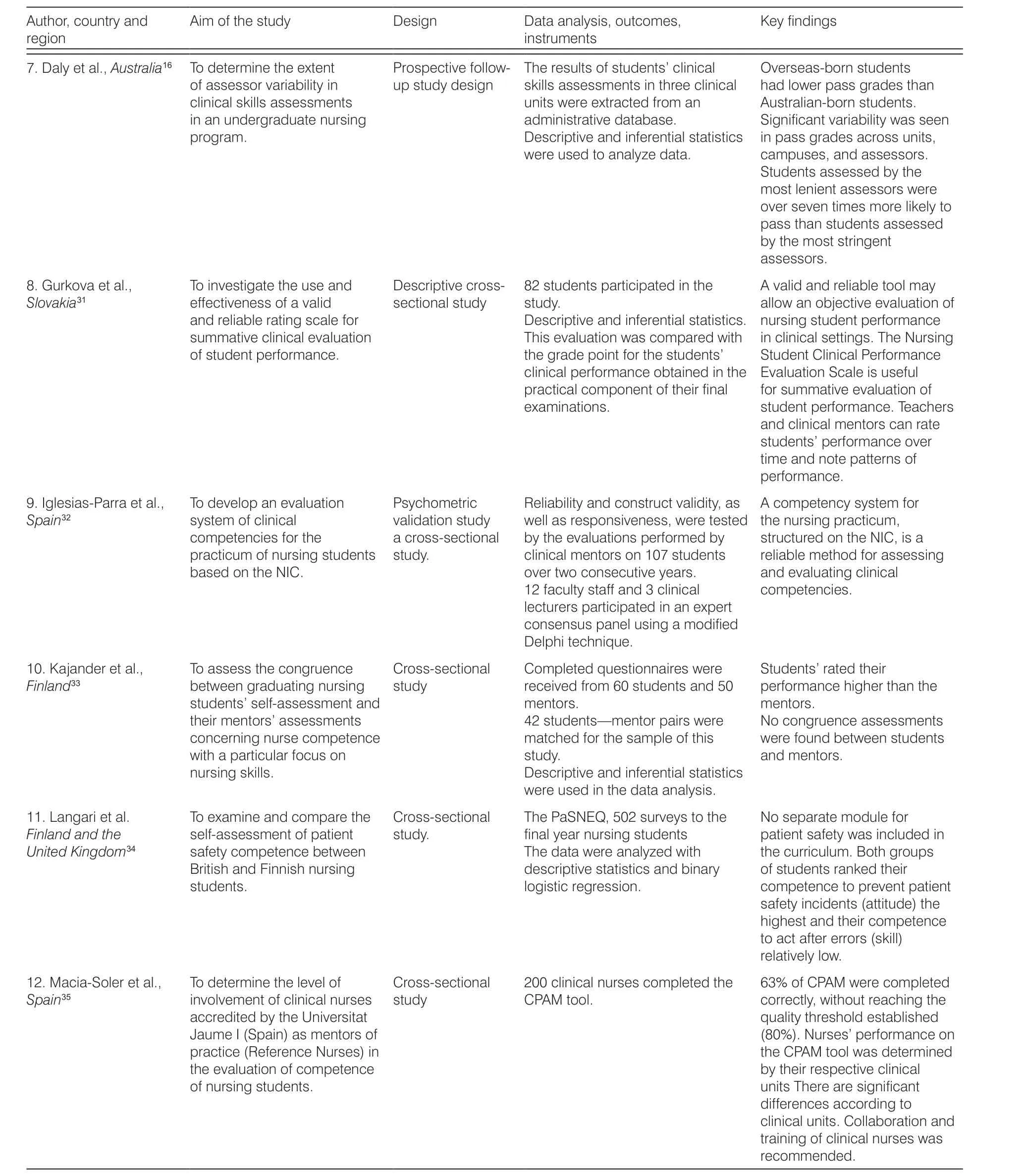
Author, country and region Aim of the studyDesignData analysis, outcomes,instruments Key findings 7. Daly et al., Australia16 To determine the extent of assessor variability in clinical skills assessments in an undergraduate nursing program.Overseas-born students had lower pass grades than Australian-born students.Significant variability was seen in pass grades across units,campuses, and assessors.Students assessed by the most lenient assessors were over seven times more likely to pass than students assessed by the most stringent assessors.8. Gurkova et al.,Slovakia31 Prospective followup study design The results of students’ clinical skills assessments in three clinical units were extracted from an administrative database.Descriptive and inferential statistics were used to analyze data.A valid and reliable tool may allow an objective evaluation of nursing student performance in clinical settings. The Nursing Student Clinical Performance Evaluation Scale is useful for summative evaluation of student performance. Teachers and clinical mentors can rate students’ performance over time and note patterns of performance.9. Iglesias-Parra et al.,Spain32 To investigate the use and effectiveness of a valid and reliable rating scale for summative clinical evaluation of student performance.Descriptive crosssectional study 82 students participated in the study.Descriptive and inferential statistics.This evaluation was compared with the grade point for the students’clinical performance obtained in the practical component of their final examinations.To develop an evaluation system of clinical competencies for the practicum of nursing students based on the NIC.Psychometric validation study a cross-sectional study.Reliability and construct validity, as well as responsiveness, were tested by the evaluations performed by clinical mentors on 107 students over two consecutive years.12 faculty staff and 3 clinical lecturers participated in an expert consensus panel using a modified Delphi technique.A competency system for the nursing practicum,structured on the NIC, is a reliable method for assessing and evaluating clinical competencies.10. Kajander et al.,Finland33 To assess the congruence between graduating nursing students’ self-assessment and their mentors’ assessments concerning nurse competence with a particular focus on nursing skills.Cross-sectional study Completed questionnaires were received from 60 students and 50 mentors.42 students—mentor pairs were matched for the sample of this study.Descriptive and inferential statistics were used in the data analysis.Students’ rated their performance higher than the mentors.No congruence assessments were found between students and mentors.11. Langari et al.Finland and the United Kingdom34 No separate module for patient safety was included in the curriculum. Both groups of students ranked their competence to prevent patient safety incidents (attitude) the highest and their competence to act after errors (skill)relatively low.12. Macia-Soler et al.,Spain35 To examine and compare the self-assessment of patient safety competence between British and Finnish nursing students.Cross-sectional study.The PaSNEQ, 502 surveys to the final year nursing students The data were analyzed with descriptive statistics and binary logistic regression.To determine the level of involvement of clinical nurses accredited by the Universitat Jaume I (Spain) as mentors of practice (Reference Nurses) in the evaluation of competence of nursing students.Cross-sectional study 200 clinical nurses completed the CPAM tool.63% of CPAM were completed correctly, without reaching the quality threshold established(80%). Nurses’ performance on the CPAM tool was determined by their respective clinical units There are significant differences according to clinical units. Collaboration and training of clinical nurses was recommended.
(Continued)
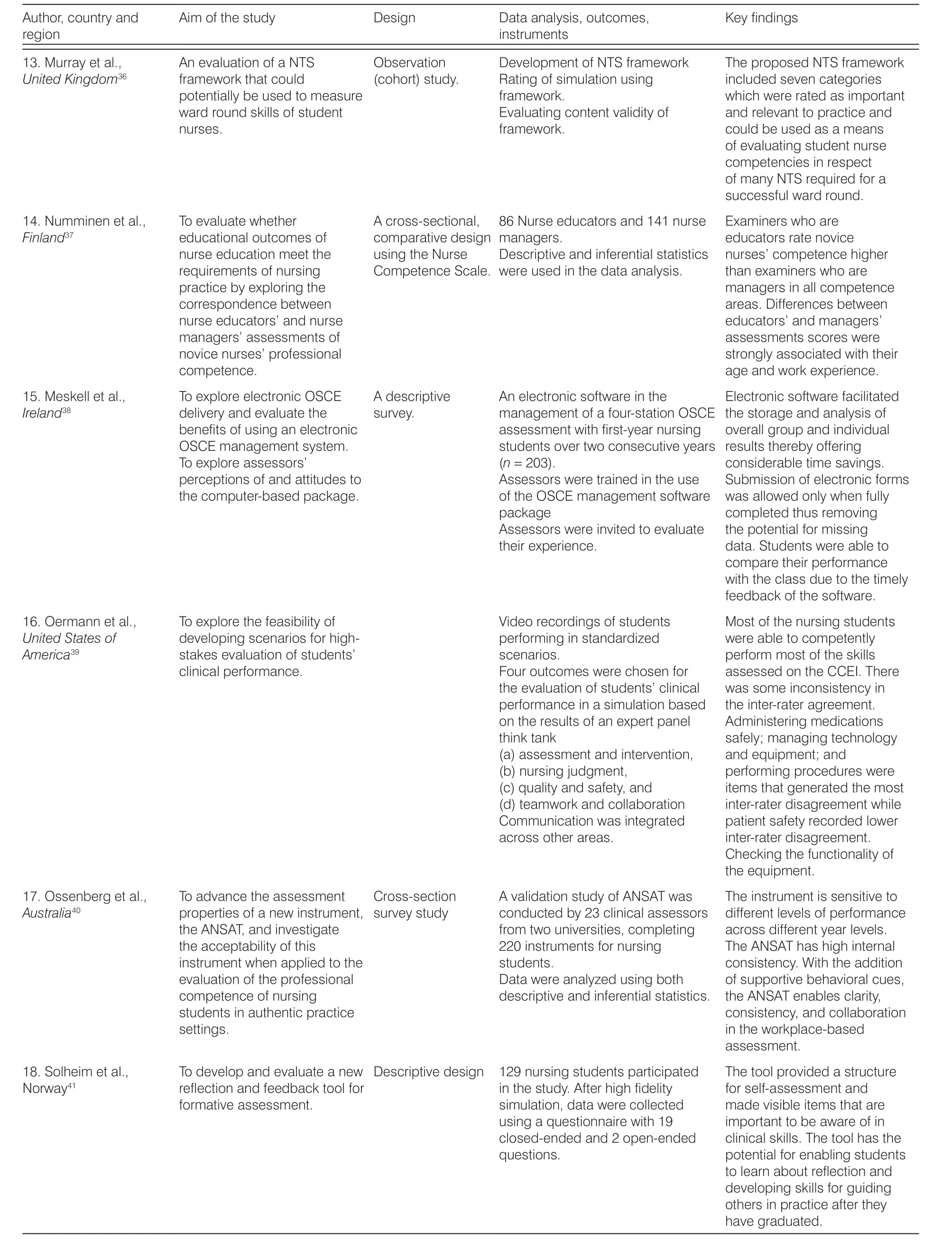
Author, country and region Aim of the studyDesignData analysis, outcomes,instruments Key findings 13. Murray et al.,United Kingdom36 The proposed NTS framework included seven categories which were rated as important and relevant to practice and could be used as a means of evaluating student nurse competencies in respect of many NTS required for a successful ward round.14. Numminen et al.,Finland37 An evaluation of a NTS framework that could potentially be used to measure ward round skills of student nurses.Observation(cohort) study.Development of NTS framework Rating of simulation using framework.Evaluating content validity of framework.Examiners who are educators rate novice nurses’ competence higher than examiners who are managers in all competence areas. Differences between educators’ and managers’assessments scores were strongly associated with their age and work experience.15. Meskell et al.,Ireland38 To evaluate whether educational outcomes of nurse education meet the requirements of nursing practice by exploring the correspondence between nurse educators’ and nurse managers’ assessments of novice nurses’ professional competence.A cross-sectional,comparative design using the Nurse Competence Scale.86 Nurse educators and 141 nurse managers.Descriptive and inferential statistics were used in the data analysis.To explore electronic OSCE delivery and evaluate the benefits of using an electronic OSCE management system.To explore assessors’perceptions of and attitudes to the computer-based package.A descriptive survey.An electronic software in the management of a four-station OSCE assessment with first-year nursing students over two consecutive years(n = 203).Assessors were trained in the use of the OSCE management software package Assessors were invited to evaluate their experience.Electronic software facilitated the storage and analysis of overall group and individual results thereby offering considerable time savings.Submission of electronic forms was allowed only when fully completed thus removing the potential for missing data. Students were able to compare their performance with the class due to the timely feedback of the software.16. Oermann et al.,United States of America39 Most of the nursing students were able to competently perform most of the skills assessed on the CCEI. There was some inconsistency in the inter-rater agreement.Administering medications safely; managing technology and equipment; and performing procedures were items that generated the most inter-rater disagreement while patient safety recorded lower inter-rater disagreement.Checking the functionality of the equipment.17. Ossenberg et al.,Australia40 To explore the feasibility of developing scenarios for highstakes evaluation of students’clinical performance.Video recordings of students performing in standardized scenarios.Four outcomes were chosen for the evaluation of students’ clinical performance in a simulation based on the results of an expert panel think tank(a) assessment and intervention,(b) nursing judgment,(c) quality and safety, and(d) teamwork and collaboration Communication was integrated across other areas.The instrument is sensitive to different levels of performance across different year levels.The ANSAT has high internal consistency. With the addition of supportive behavioral cues,the ANSAT enables clarity,consistency, and collaboration in the workplace-based assessment.18. Solheim et al.,Norway41 To advance the assessment properties of a new instrument,the ANSAT, and investigate the acceptability of this instrument when applied to the evaluation of the professional competence of nursing students in authentic practice settings.Cross-section survey study A validation study of ANSAT was conducted by 23 clinical assessors from two universities, completing 220 instruments for nursing students.Data were analyzed using both descriptive and inferential statistics.To develop and evaluate a new reflection and feedback tool for formative assessment.Descriptive design 129 nursing students participated in the study. After high fidelity simulation, data were collected using a questionnaire with 19 closed-ended and 2 open-ended questions.The tool provided a structure for self-assessment and made visible items that are important to be aware of in clinical skills. The tool has the potential for enabling students to learn about reflection and developing skills for guiding others in practice after they have graduated.
(Continued)
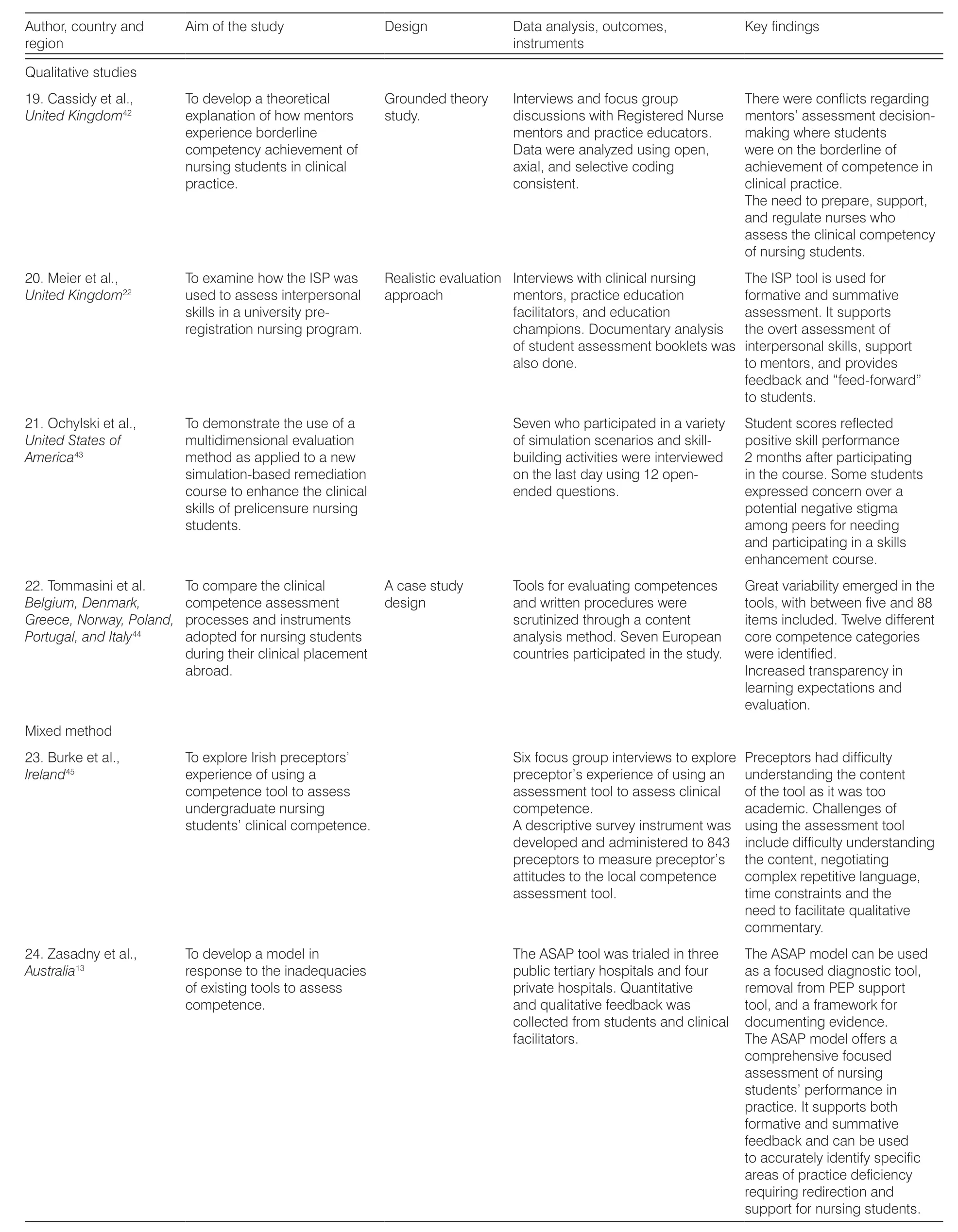
Author, country and region Aim of the studyDesignData analysis, outcomes,instruments Key findings Qualitative studies 19. Cassidy et al.,United Kingdom42 There were conflicts regarding mentors’ assessment decisionmaking where students were on the borderline of achievement of competence in clinical practice.The need to prepare, support,and regulate nurses who assess the clinical competency of nursing students.20. Meier et al.,United Kingdom22 To develop a theoretical explanation of how mentors experience borderline competency achievement of nursing students in clinical practice.Grounded theory study.Interviews and focus group discussions with Registered Nurse mentors and practice educators.Data were analyzed using open,axial, and selective coding consistent.To examine how the ISP was used to assess interpersonal skills in a university preregistration nursing program.Realistic evaluation approach Interviews with clinical nursing mentors, practice education facilitators, and education champions. Documentary analysis of student assessment booklets was also done.The ISP tool is used for formative and summative assessment. It supports the overt assessment of interpersonal skills, support to mentors, and provides feedback and “feed-forward”to students.21. Ochylski et al.,United States of America43 To demonstrate the use of a multidimensional evaluation method as applied to a new simulation-based remediation course to enhance the clinical skills of prelicensure nursing students.Seven who participated in a variety of simulation scenarios and skillbuilding activities were interviewed on the last day using 12 openended questions.Student scores reflected positive skill performance 2 months after participating in the course. Some students expressed concern over a potential negative stigma among peers for needing and participating in a skills enhancement course.22. Tommasini et al.Belgium, Denmark,Greece, Norway, Poland,Portugal, and Italy44 To compare the clinical competence assessment processes and instruments adopted for nursing students during their clinical placement abroad.A case study design Tools for evaluating competences and written procedures were scrutinized through a content analysis method. Seven European countries participated in the study.Great variability emerged in the tools, with between five and 88 items included. Twelve different core competence categories were identified.Increased transparency in learning expectations and evaluation.Mixed method 23. Burke et al.,Ireland45 Preceptors had difficulty understanding the content of the tool as it was too academic. Challenges of using the assessment tool include difficulty understanding the content, negotiating complex repetitive language,time constraints and the need to facilitate qualitative commentary.24. Zasadny et al.,Australia13 To explore Irish preceptors’experience of using a competence tool to assess undergraduate nursing students’ clinical competence.Six focus group interviews to explore preceptor’s experience of using an assessment tool to assess clinical competence.A descriptive survey instrument was developed and administered to 843 preceptors to measure preceptor’s attitudes to the local competence assessment tool.To develop a model in response to the inadequacies of existing tools to assess competence.The ASAP tool was trialed in three public tertiary hospitals and four private hospitals. Quantitative and qualitative feedback was collected from students and clinical facilitators.The ASAP model can be used as a focused diagnostic tool,removal from PEP support tool, and a framework for documenting evidence.The ASAP model offers a comprehensive focused assessment of nursing students’ performance in practice. It supports both formative and summative feedback and can be used to accurately identify specific areas of practice deficiency requiring redirection and support for nursing students.
(Continued)
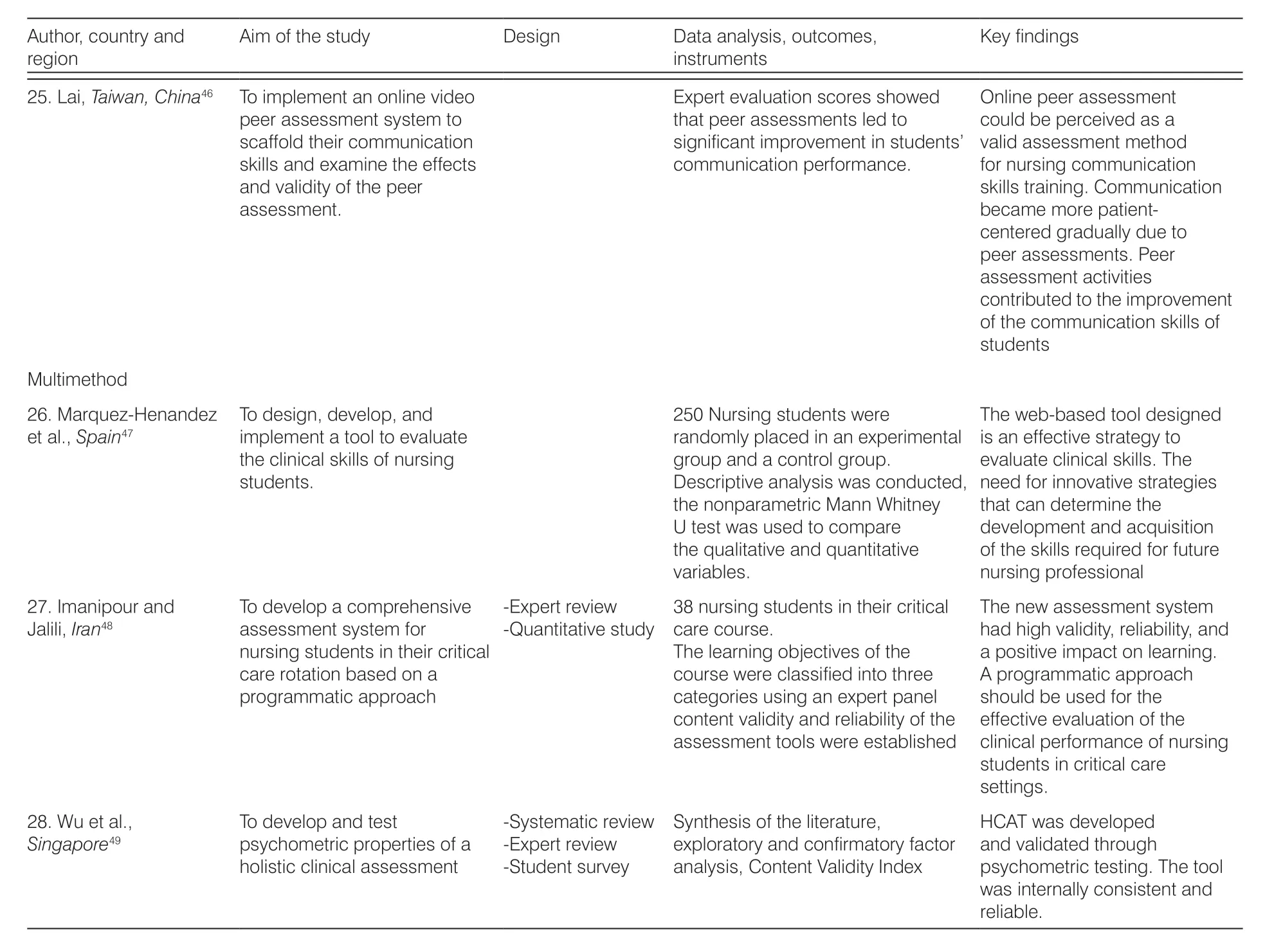
Table 1. Data matrix.
3. Results
Data were synthesized into five categories namely:clinical competency systems and tools; qualities of the assessment Systems/Tools/Frameworks/Models;strengths and weaknesses of the assessment process; management of assessment process; and quality improvement of the examination system. Sub-categories were also presented below.
3.1. Clinical competency assessment tools
The tools used in the included studies were developed either to assess technical skills or non-technical skills(NTS). Technical skills include: patient assessment13;nursing care process31,44; managing patient care and education44; wound dressing48,51; catheterization41,47,48,51;inserting feeding tube41; inserting a nasogastric tube51;preparation and administration of parenteral medication41,47; handwashing38; documentation38; blood sampling48; inserting peripheral lines41and management of care.49
NTS that were assessed included: self-learning and critical thinking44; interpersonal skills22; ethical behavior44; nurse-patient communication36,44; risk prevention44; nursing students’ communication performance on advocacy, the therapeutic use of self and validation to patients and family46; and ethical principles and professionalism.31
The studies presenting the tools in Table 2 were mainly focused on the assessment of clinical competency skills29; preceptor experience of using competency tools45; anxiety level of students during the assessment28; assessment practices of nurse educators and managers37; involvement of clinical nurses as mentors35;mentors experiences when nursing students are on the borderline of achievement of competence in clinical practice.42Other areas included comparing nursing students’self-assessment and mentors’ assessments on competency skills33; and influence of assessors,16professional,legal and ethical nursing practice, leadership and nursing management and professional development.49
3.2. Qualities of assessment systems/tools/frameworks/models
Quality assessment tools/systems/frameworks should have the following features: objectivity and feasibility22,48; educational impact45,48; validity and reliability22,26,31,32,38,40,49,51; defined scope13; defined procedures44;measuring dimensionality of the tool51; utility of the tool22,40; transparency and clarity22,44,49; relevance40,49; efficient/timely to complete40; data storage38; support reflection41,49and provide feedback (Figure 3).13,22,31,39,41,45,46,48,49
3.3. Strengths and weaknesses of the assessment process
Strengths and weaknesses were identified in the clinical competency assessment systems. The authors identified improved self-confidence26; critical thinking26and good communication34,43,46; collaboration and teamwork43,46; effective remediation35; quality nursing care29and monitoring students’ progress49as strengths of assessment systems. Using different evaluation forms44; incongruence between teaching and assessment22; no module on patient safety in the curriculum34;overwhelming clinical scenarios39; and difficulty with face-to-face interaction22and lengthy assessment tool49were identified as weaknesses in clinical competency assessment.
3.4. How the assessment system should be managed
Findings from the synthesis outlined some aspects (subcategories) of managing the assessment processes,such as testing assessment tools, examiner-related factors, supporting students, scoring performances, and educational effects that are critical for a quality clinical competency assessment.
3.4.1. Pilot testing of the assessment system
Before commencing a clinical competency examination,there is a need to conduct a pilot test of the assessment tools and scenarios in the examination setting. Pilot testing helps correct any errors regarding scenarios39andensures clarity and transparency in selecting items for the assessment process.22,49Also, using manikins’ functionality and other instruments such as cameras and microphones helps to capture relevant data for storage and reference.39Testing instruments ensures that students and examiners are familiar with the assessment tools before examination45as evident in all the tools that were described in Table 1.
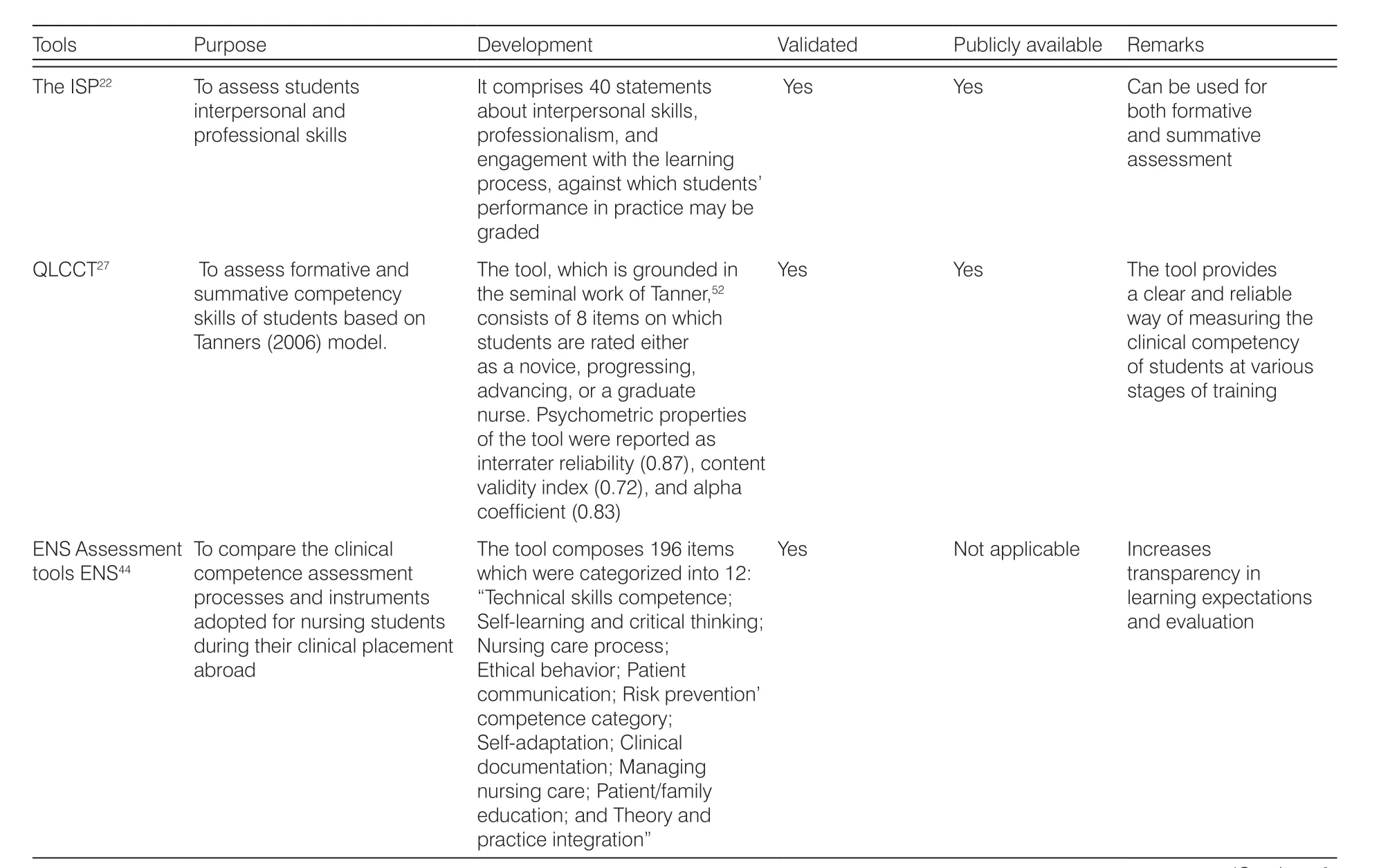
ToolsPurposeDevelopmentValidated Publicly available Remarks The ISP22 To assess students interpersonal and professional skills It comprises 40 statements about interpersonal skills,professionalism, and engagement with the learning process, against which students’performance in practice may be graded Yes Yes Can be used for both formative and summative assessment QLCCT27 To assess formative and summative competency skills of students based on Tanners (2006) model.The tool, which is grounded in the seminal work of Tanner,52 consists of 8 items on which students are rated either as a novice, progressing,advancing, or a graduate nurse. Psychometric properties of the tool were reported as interrater reliability (0.87), content validity index (0.72), and alpha coefficient (0.83)YesYes The tool provides a clear and reliable way of measuring the clinical competency of students at various stages of training ENS Assessment tools ENS44 To compare the clinical competence assessment processes and instruments adopted for nursing students during their clinical placement abroad The tool composes 196 items which were categorized into 12:“Technical skills competence;Self-learning and critical thinking;Nursing care process;Ethical behavior; Patient communication; Risk prevention’competence category;Self-adaptation; Clinical documentation; Managing nursing care; Patient/family education; and Theory and practice integration”Yes Not applicableIncreases transparency in learning expectations and evaluation
(Continued)

ToolsPurposeDevelopmentValidated Publicly available Remarks ASAP toolamalgamated student assessment in practice model13 The ASAP model functioned effectively as an assessment tool,focused diagnostic tool,removal from PEP support tool, and a framework for documenting evidence The model comprises an assessment tool, a clinical reasoning framework and a negotiated learning contract.The tool assesses developing competence into levels of safe,safe and effective, and lastly safe, effective and proficient.These levels of competence development are applied to each of the components of competence: knowledge, skills,and attitudes/behaviors Yes Yes It is useful for both formative and summative assessment ICAS tool53To assess the communication competencies of students in undergraduate programs This tool is a 23 items tool.Psychometric testing produces a Cronbach’s alpha of 0.96.Yes YesUsed for summative and formative assessment clinical performance H-PEPSS54To assess patient safety competencies of students NSCPES31To assess the summative clinical performance of nursing students Six domains of the safety competencies: “Contribute to a culture of patient safety; Work in teams for patient safety;Communicate effectively for patient safety; Manage safety risks; Optimise human and environmental factors; and Recognise, respond to and disclose adverse events”Instrument development consists of 77 items of clinical responsibilities of nursing students.Yes Yes It is an effective tool in assessing summative clinical performance Yes Yes A valid and reliable tool may allow an objective evaluation of Nursing students’ performance in clinical settings.DOPS55To assess students clinical performance through direct observation Not applicableNot applicable Insufficient training,poor feedback, time constraints. Attention needs to be paid to the quality of the tests NTS-NAS56To assess the not technical skills of nursing students Many variant forms of tools are in use. Khanghahi and Azar (2018)presented a systematic review of the DOPS used.NTS-NAS resulted in a list of 63 items that are assessed on a 5-point Likert scale: “totally disagree to totally agree”with intermediaries. A “nonapplicable” option was also added.YesYesThis tool could be used in teaching and assessment in undergraduate and postgraduate programs CCEI57To assess clinical competency of nursing students in simulation or traditional clinical settings The tool focuses on 22 general nursing behaviors which were divided into four categories:“assessment, communication,clinical judgment, and patient safety”.Yes YesThis tool has been validated and is used in many countries ANSAT40The instrument tested contained 17 items spread across 4 domains of practice used to assess the student’s level of ability.The items are rated using a A 17 item tool which is rated on a 1—4 scale. The tool is categorized into 4 domains:“professional practice; critical thinking and analysis; provision and coordination of care; and collaborative and therapeutic practice”. The scale is calibrated as: “1 = minimum standards not met, 2 = minimum standards met, 3 = performs above minimum standards in some areas, 4 = performs above minimum standards in most areas”.Yes YesIt allows for clarity,reliability, and collaboration in clinical competency assessment
(Continued)

Table 2. Clinical competency assessment systems/tools/frameworks/models.
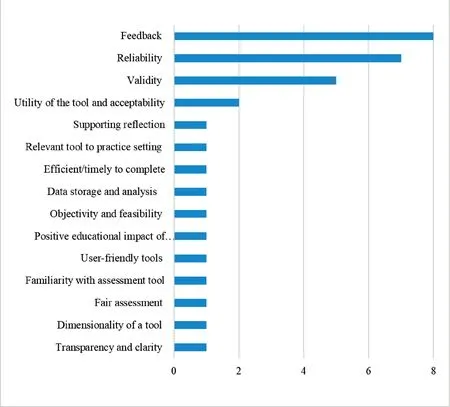
Figure 3. Quality criteria mentioned in the papers included.
3.4.2. Examiner-related factors
Lack of training of examiners, workload, and lack of time makes assessment challenging.22Some examiners also complained about the assessment tools’ language being too academic and complicated, lengthy and time-consuming, so they end up skipping some of the problematic sections.45Some examiners have challenges with awarding “excellent” and excellent grades in some of the higher items, such as confidence in decision-making and being innovative, as they believe that may be difficult to achieve in specialist areas.22Some examiners also struggle when they are not well trained, not familiar with the practice setting, not experienced, not confident, and not competent in what is being assessed.22,38,39Therefore, preceptors, mostly examiners, felt prepared and fulfilled after going through a training course.45Nurse educators and nurse clinicians appointed as examiners need to be well trained to assess students.22,45Training also prepared examiners to cope with the fear of failing non-performing students.22
3.4.3. Supporting students
To support students, examinations must be done in a safe environment to reduce anxiety,43and must provide timely support to students when a concern is identified.45In assessing interpersonal skills profiles (ISPs), examiners may need to create an enabling environment such as engagement, confidence in judgment, and welcoming students.22,39Students are believed to be motivated when their good practice is rewarded.22Competencedevelopment Practical Procedures (COPP) helped clarify what to focus on when giving feedback and is used to raise awareness among students on quality in skills training.41Essential areas such as hygiene principles,preparing equipment, being more thorough in what to assess as an observer, and information given to the patient and completing work and documentation were identified.
3.4.4. Scoring performance
According to examiners, tools aid in assessing in a safe,effective and proficient manner.13Tools allow the collection of data that can be disseminated later to students and faculty13and can be used as a guide or framework to support examiners’ judgments.45The clinical examination results are expressed in different formats such as dichotomous (pass/fail) measurement to an ordinal scale using a five to 20 Likert scale score.44It was reported that students assessed by the most lenient assessors were over seven times more likely to pass than students assessed by the most stringent assessors.16Although language affects performance, for example, indigenous students performed better than international students,the strongest predictor of a student passing their clinical skills assessment was the leniency (doves) and stringency (hawks) of the examiner.16
There are other variabilities in the assessment of clinical competence by nurse educators and nurse managers. The age difference between educators and managers also influences the award of marks to students.Numminen37discovered that educators and nurse managers who were <50 years of age award lower marks than those over the age of 50. The finding calls for an investigation of the association between age, expertise groups, and student assessment. Also Oermann et al.39discovered inter-rater disagreement in the assessment of administering medication, managing technology, and equipment. It was found that the inconsistent the performance of students.39In some instances, the software is embedded to forecast a new pass mark to control stringent and lenient examiners.38Fatigue also affects the award of marks. Evaluators needed to break and rest after viewing four videos of students performing clinical competence due to fatigue, indicating there may be the need to extend the duration of the examination.39Novice examiners’ rating skills improved after examining eight videos. Also, it was easier to rate outstanding and poor performance than average.39In clinical assessment, students must be allowed to evaluate the examination system, tools, and examiners.47,48
3.4.5. Educational effect
Assessment of clinical competency skills of students,using various assessment tools, leads to skills improvement. Some students expressed concern over a potential negative stigma among peers for needing and participating in a skills enhancement course.43During peer assessment, students were able to provide feedback to their peers.46Students identified the importance of patient safety and were confident that they could respond to adverse effects toward patients,34while most students were able to competently perform most of the skills assessed on the Creighton Competency Evaluation Instruments (CCEI).39There was no difference in anxiety level when examined using the traditional method or video method on performance.28Formative clinical competency assessment creates an awareness among students to improve their clinical skills.41In effect,examination helps to provide feedback to students and identify their learning needs, towards the provision of remedial activities to enhance learning.45,49
3.5. Quality improvement of the assessment system
Although most of the articles showed that the current assessment systems were effective (Table 1), there is a need for improvement in some areas. The need for more collaboration between nurse educators and managers could reduce the inter-rater variability and bridge the theory-practice gap.37,45Some competency skills, such as handwashing and communication, need to be assessed exclusively to ensure that students are competent in those areas.30Students must be exposed to skills continuously to improve clinical competency performance,29identifying their learning needs and styles,45increase collaboration, and continuously develop professionally.49Additionally, continuous review of assessment tools, providing space on the sheet for examiners’ comments, and including the assessment of ISP in all assessment systems improve the assessment
4. Discussion
The results highlighted various aspects of assessment of clinical competency: research output on clinical competency assessment; clinical competency assessment tools in use; criteria for quality clinical competency assessment; the management of clinical competency assessment system; and quality improvement of the examination system.
There was only one study included from the African context. The lack of research on clinical competency assessment in the sub-region may lead to practitioners using evidence from a different context to guide their assessment systems. This phenomenon, if not handled cautiously, may result in ineffective, Eurocentric systems that are not responsive to the SSA context. Previous reviews2,58found that there is a paucity of nursing and midwifery education research in SSA. It is therefore essential for research on clinical competency assessment from Europe and other regions to be contextualized before guiding practice in SSA.19
There are several tools for the assessment of various aspects of clinical competency. Almost all the tools that were used in the studies were validated (Table 2).They are publicly available to guide teaching and practice, which is important in summative assessment as the students and the educators can identify the expectations of the assessment system and prepare accordingly.44,45This helps to bridge the theory-practice gap.Available tools allow students to engage in peer assessment, which is beneficial to them.46
A good assessment system must meet some quality criteria. It must: be fairly objective, measure what it is set to measure; produce the same result if it is conducted under similar conditions; be applicable within the context for which it is developed; be acceptable to the stakeholders within the context; be transparent and clear; result in improvement in teaching, learning and practice; and provide feedback to the stakeholders for quality improvement purpose. Any assessment system that is devoid of these qualities will be fraught with biases and unfairness, which will, in turn, lead to licensing of incompetent practitioners or denying competent practitioners license to practice with its associated risk to society.15
Just like every functional and effective system,clinical competency assessment systems must be thoroughly planned, developed, and pilot tested before implementation. This ensures that the recipients of the products or outcomes of the system are satisfied with it. The tools used for every assessment system must be validated. Validation of tools gives students confidence in the assessment system. It also ensures the validity and reliability of the assessment. Training of the examiners is essential in ensuring the applicability and reliability of the assessment system and should include the award of marks and the provision of a safe and conducive examination environment. This is observed through their confidence, good inter-rater reliability, and the students’ satisfaction. An incompetent examiner risks the introduction of bias which hampers the quality of the assessment system.16In selecting examiners,consideration must be given to the age category and competency skills to be assessed as it affects the outcomes of the examination.37
Feedback is essential in the continuous improvement of an examination system. Students, examiners,and educators must be allowed to evaluate the examination system and the tools used to provide empirical evidence on which quality improvement could be based. Feedback from the examination body in terms of publishing anonymized examination results also provides the institutions and students data for quality improvement. Feedback on various aspects of the care provided by students during formative clinical competency assessment provides data on learning needs, remediation, and improvement in clinical competency.
5. Conclusions
A good assessment system must be valid, reliable,transparent, feasible, must provide feedback, continually improve, must be fair, must be objective, and have an educational impact. Clinical competency assessment systems must be developed on sound empirical evidence, pilot tested, and involve thorough training and evaluation of the examiners. Continuous evaluation of the assessment system is also essential in ensuring the quality and relevance of an assessment system. The paucity of clinical competency assessment research in sub-Saharan Africa may lead to benchmarking assessment systems on research conducted outside the context. Sub-Saharan Africa has a set of circumstances that demand a context-specific clinical competency assessment framework to guide clinical competency assessment in the sub-region.
The study presents a review and synthesis of empirical evidence on clinical nursing competency assessment globally. The findings highlighted critical areas that need attention in designing and improving clinical competency assessments systems especially in licensing examinations, which serve as the bridge between training and qualification as a nurse in many countries globally. The findings in this study, if applied, will assist in ensuring that only competent nurses are license to practice nursing, thereby protecting the public against malpractices.
Acknowledgment
We would like to acknowledge Professor Gerda Reitsma and the centre for Health Professions Education, North-West University for their support during the manuscript writing phase. Special thanks to Dr. Kwame Anim-Boamah for his support during the study.
Ethical approval
Ethical issues are not involved in this paper.
Conflicts of interest
All contributing authors declare no conflicts of interest.
杂志排行
Frontiers of Nursing的其它文章
- Rescue of a patient with a 50 cm broken PICC tube retracted and wrapped in pulmonary artery: a case report
- Relationship between clinical performance and professional self-concept in critical care nurses
- Clarivate listed nursing journals in 2020:what they publish and how they measure use of social media
- Caregiver empowerment program based on the adaptation model increase stroke family caregiver outcome
- Factors associated with active aging in Chinese elderly in rural areas of Xiangtan County, China†
- Relationship between quality of professional life and organizational commitment in intensive care unit nurses
